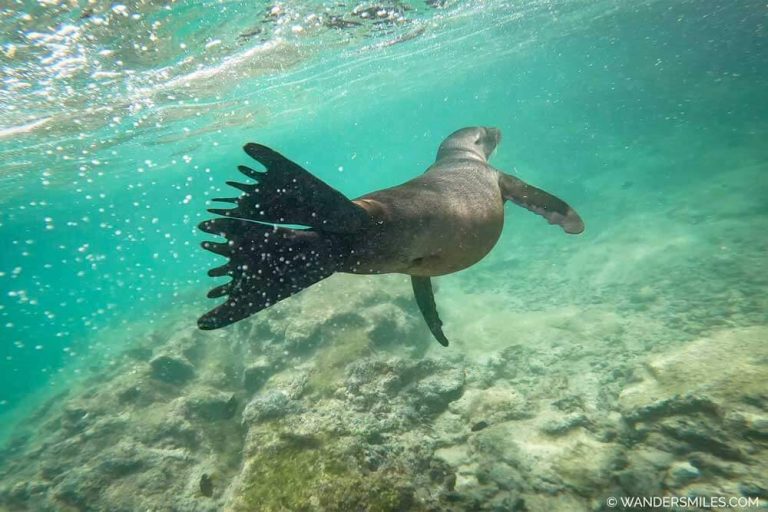Concha de Perla, or pearl shell, is a natural rock formation on the island of Isabela in the Galapagos Islands, shaped and influenced by the changing tides of the sea.
The rich marine biodiversity and unique ecosystem make Isabela Island a prime destination for those seeking unforgettable encounters with diverse and fascinating wildlife.
The best part? It's free. Why miss the opportunity to visit natural wonders without paying a price? Snorkeling at Concha de Perla is not to be missed!


Diving in Concha de Perla: Need to know
Where is Concha de Perla located?
Concha de Perla is located next to the boat dock on Isabela Galapagos Island. If you are coming from Puerto Villami, the opening will be on the left after the snack bar hut.
How do I get to Concha de Perla?
From Puerto Villamil, visitors can walk (15-20 minutes) to Concha de Perla or take a taxi if the weather is very hot. If you are arriving by bike, there is a place to store your bike as it is not allowed on the walkway.
Once you reach the entrance, you can take a short walk along the boardwalk through the mangrove forests to the secluded Concha de Perla Lagoon.
Sea lions often rest on the boardwalk at Concha de Perla to take advantage of the shade.
As I was trying to leave Concha de Perla, the sea lions were completely blocking the way and were a bit agitated since they had a younger pup with them. During low tide, I climbed the fence and walked around the blockade.
Don't be surprised to find seals and marine iguanas hanging out on the deck when you arrive.


When is the best time to visit Concha de Perla?
the The best time of year to visit Concha de Perla From December to May, providing ideal conditions for snorkelling with warmer weather and calmer waters. From June to November, temperatures can be a little cooler but it is still a pleasure to go snorkeling in Concha de Perla all year round.
the Best time of day to visit Concha de Perla At low tide when visibility is best. Check tide times To be on the safe side.
Concha de Perla opening hours It is 6am – 6pm.
What to take to Concha de Perla
Here's a handy list of what you'll need to snorkel in Concha de Perla, starting with the obvious!
- Snorkel and face mask – Bring your own or rent from tourist agencies and dive shops in town.
- From GoPro – A must if you want to take pictures of amazing marine life.
- sunblock cream – The higher factor is the better to protect yourself from the tropical sun, and Reef safe sunscreen To protect the animals' habitat.
As always, remember that Leave no trace. Do a final check and make sure everything is packed before leaving the site.
Tips for diving in Concha de Perla
Snorkeling at Concha de Perla is an amazing experience, but there are a few tips you should be aware of.
- Do not touch animals. Keep your distance and let the wildlife do what they want. Humans can appear threatening, especially during breeding seasons.
- Do not touch the coral. Walking or standing on coral reefs harms the balance of the marine ecosystem. And it can give you a bad cut at the same time!
- Do not exceed the rope. In Concha de Perla, a rope prevents swimmers from venturing towards the Los Tintoreras site, helping to regenerate damaged coral reefs. Entry is allowed only with an official guide from the national park via boat.
- Do not enter the water at high tide. On one of my visits at high tide, the water was very choppy and it was difficult to swim against the strong current. Seeing a marine iguana clinging to the walkway should be a sign not to enter the water. Marine iguanas are equipped with large, hooked claws, while humans are not.


Wildlife in Concha de Perla
Concha de Perla, located on the island of Isabela, is a great place for wildlife lovers. Ideal for leisure time during an extended stay, its appeal lies in the unpredictability of the sights – penguins, sea turtles, marine iguanas, sea lions, mockingbirds, reef sharks and more.
With a few visits to Concha de Perla, I've ticked some wildlife experiences off my animal bucket list.
Swim with a marine iguana
Marine iguanas are everywhere you look on Isabela Island, spending most of their time in the sun. I've seen marine iguanas from far away in the water, so seeing one swimming next to my snorkel mask was a dream.
Evolved from land iguanas, their ability to adapt to water shines through. Flat tails and webbed feet aid swimming. Marine iguanas do not have gills, but they can hold their breath for a long time when they need to dive to feed on seaweed and algae. When they swim, they need to breathe air, so they emerge from the water (just like us).
|| Fun fact
The Galapagos marine iguana is silent, relying on the alarm call of the Galapagos mockingbird. Both creatures are targeted by the Galapagos hawk, so the iguana heeds the mockingbird's warning to avoid predation.


Swimming with seals
Swimming with seals was at the top of my list of Galapagos wildlife experiences. This beautiful creature blasted a spin with its streamlined body, then flipped acrobatically to return while using its front flippers to gain high speed. No wonder they call sea lions “sea ballerinas”!


Watch sea turtles
Sea turtles are a common occurrence in Concha de Perla, each one as special as the last. Watching Galapagos green turtles slowly feed on the sea floor and slide to the surface in search of air was a great honor.


Watch tropical fish
Many species of tropical fish call concha de perla home. Because the lagoon is surrounded by coral reefs, the most common species found in Concha de Perla thrive in this environment.
black and yellow damselfish, Galapagos Gregory (Stegastes arcifrons), can be seen aggressively chasing other fish that dare to cross into its territory. They have no qualms in attacking your toes as a message to back off.
the Parrot fish is inconspicuous (Scarus Ghobban) usually searches for food in sedimentary clouds. Their molten teeth are ideal for extracting filamentous algae from dead coral. Because they depend on coral reefs for food, they are vulnerable to ongoing coral degradation.
the Sergeant Major Damselfish (Apoddiffus saxatilis) is named because of its five dark stripes between its silvery-yellowish-gray sides. They often feed in large schools, swimming over shallow coral reefs. At the far end of Concha de Perla, groups can be seen nibbling on algae collected on ropes that prevent swimmers from going any further.
Isabela Galapagos Island: Useful Links
Pin for diving in Concha de Perla Isabela Galapagos
Disclosure: This post contains affiliate links, which means I may receive a small commission if you click a link and purchase something I recommended. It comes at no cost to you. thanks for your support.

